
DENVER–(BUSINESS WIRE)–On September 29, 2022, after the Federal Energy Regulatory Commission rejected Tri-State’s proposed Contract Termination Payment methodology, a FERC Administrative Law Judge granted distribution cooperatives another victory when it issued an Initial Decision for determining the methodology for calculating the exit fee to be paid by members of Tri-State Generation & Transmission Association seeking to withdraw from the generation and transmission cooperative. This ruling is also highly relevant to those Tri-State customers seeking to know the cost methodology for withdrawing in the future.
Context on the Matter
The dispute over the appropriate Tri-State CTP methodology stems from Tri-State Members’ attempts to exit the cooperative membership, and the FERC’s determination on June 17, 2021 that Tri-State’s earlier CTP methodology proposal failed to provide fair and transparent procedures for Members considering such termination. In that June 17 ruling, the Commission and the ALJ outright rejected Tri-State’s proposed CTP methodology that required exiting customers to pay all future revenues that would be lost to Tri-State.
“The ALJ methodology respects the distribution cooperatives’ role as a customer and owner and paves the way for a just and reasonable transition for exiting cooperatives and the G&T moving forward,” said Robin Lunt, Chief Commercial Officer of Guzman Energy. “The ALJ and FERC staff created a robust record and roadmap that we anticipate will pave the way for a favorable Commission decision enabling distribution cooperatives to evaluate competitive power supply options.”
ALJ’s Recommended Approach for Final FERC Decision
On September 29, 2022, the FERC ALJ adopted a balance sheet approach to measure the liabilities (i.e., debt and other obligations) that Tri-State has incurred to serve a departing member and assigns said member a pro rata share of these liabilities. Responsibility for Tri-State’s debt and PPAs is allocated to exiting cooperatives based upon the past three-year average share of Member billings (as opposed to patronage capital share).
In addition, the ALJ identified specific treatments for the following key points upon an exit:
- Transmission – Respecting Tri-State’s role as a generation and transmission owner, and the fact that the exiting members will remain transmission customers after an exit, the ALJ’s adopted approach offsets future revenue from the withdrawing Member’s expected use of future Tri-State transmission services against the Member’s total pro rata share of debt on the balance sheet.
- Patronage Capital – The ALJ’s adopted approach gives departing Members a choice between continuing to receive its allocated equity (patronage capital) payments according to Tri-State’s rotation schedule or taking a discounted lump sum payment.
- PPAs – Tri-State would assign a value for each PPA and provide the Member with the opportunity to buy down its obligations under the PPA or alternatively, to sleeve its pro rata share of the contract and take the power. WAPA PPAs would go with the departing load and Basin PPAs remain open pending another docket.
The ALJ’s Initial Decision is now subject to review by FERC. Interested parties to the proceeding will have the opportunity to brief their positions on the Initial Decision. A final decision from FERC is currently expected around July 2023.
Guzman Energy, as an interested party, intervened and participated in the proceeding. Guzman works with distribution cooperatives that often seek full or partial G&T exits in order to leverage competitive market pricing for power and pursue their own local power generation assets.
About Guzman Energy
Guzman Energy is a wholesale power provider dedicated to communities in search of affordable and reliable energy. We partner with cooperatives, municipalities, companies, and tribes across North America to customize energy portfolios that make economic and environmental sense for today and tomorrow. Together, we are lighting the way forward. Visit guzmanenergy.com.






